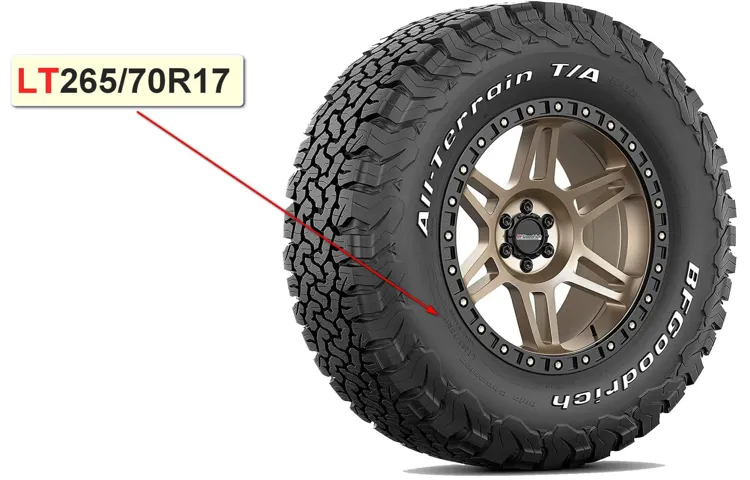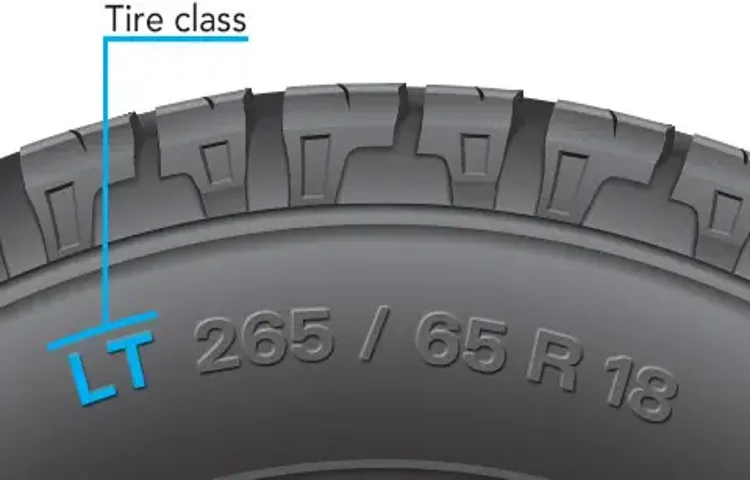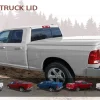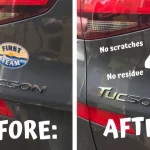If you’ve ever looked at the sidewall of a tire, you may have noticed some letters and numbers etched into it. One of these markings is often a combination of the letters “LT”. But what does LT mean on a tire? Well, simply put, “LT” stands for “Light Truck”.
This means that the tire is designed for use on light-duty trucks and SUVs. LT tires are constructed with stronger, stiffer materials than passenger car tires to handle the extra weight and stress of larger vehicles. They also typically have more aggressive tread patterns for better traction on rough terrain.
But why is it important to know what LT means on a tire? Understanding the designation of your tires is crucial for ensuring that you have the right type of tire for your vehicle and driving needs. Using the wrong kind of tire could result in poor handling, reduced traction, and even safety hazards. So, next time you’re shopping for new tires or examining the ones on your vehicle, take a closer look at the sidewall and check if they have the “LT” marking.
If they do, you’ll know that they’re designed for light trucks and SUVs and can confidently make your purchase or plan your next adventure!
Table of Contents
Understanding Tire Labeling
If you’ve ever looked at a tire label, you may have noticed a letter and a few numbers, such as LT235/75R1 The “LT” in this case stands for “Light Truck,” indicating that these are tires made specifically for trucks, vans, or SUVs. This is important to pay attention to, as LT tires are built to handle heavier loads than passenger car tires.
It’s crucial to make sure that your vehicle is equipped with the appropriate type of tire for your driving needs. This information can all be found on the tire label, which provides a wealth of information regarding the tire size, load capacity, maximum speed, and other important details. Understanding tire labeling can seem overwhelming at first, but taking the time to educate yourself on the subject can make a big difference in the safety and performance of your vehicle.
So next time you’re in the market for new tires, make sure to pay attention to the labeling and choose a tire that’s right for you.
LT vs. P-Metric Tires
When it comes to buying tires, it’s important to understand the labeling system to make an informed decision. One significant aspect of labeling is differentiating between LT (Light Truck) and P-Metric tires. LT tires have a more robust construction, making them suitable for heavy-duty pickup trucks and SUVs that often carry heavy loads or tow trailers.
On the other hand, P-Metric tires are designed for lighter vehicles like passenger cars and smaller SUVs. They have a simpler construction that prioritizes ride comfort and fuel efficiency over durability. As a result, P-Metric tires are more affordable, while LT tires on the other hand are more expensive and less fuel-efficient.
It’s important to choose the right tire type for your vehicle to ensure maximum safety and performance on the road.

Application of LT Tires
As a car owner, it’s essential to understand the labeling on your tire to ensure optimal performance and safety on the road. One important aspect of tire labeling is LT, which stands for Light Truck. LT tires are designed for heavier loads and more significant towing capacities, making them an ideal choice for trucks, SUVs, and other heavy-duty vehicles.
The labeling on these tires indicates the tire’s capacity, load index, and speed rating. A detailed understanding of these factors will help you choose the right tire for your vehicle and needs. It’s crucial to note that LT tires may differ from passenger car tires, so it’s essential to consult with a professional to ensure you’re making the right choice.
Overall, understanding tire labeling can help you make informed decisions about your vehicle’s safety and performance and can help you get the most out of your tires in any situation.
Interpreting the LT Designation
If you’re looking to buy new tires you might have noticed the “LT” designation on some of them. So, what does the “LT” on a tire mean? Well, it stands for “Light Truck,” indicating that the tire is designed for use on trucks, SUVs, and vans. LT tires are typically built to handle heavier loads and tougher conditions than regular passenger car tires.
They have a higher load-carrying capacity and a stiffer sidewall to offer extra stability and support when carrying heavy cargo or towing trailers. It’s important to note that not all trucks require LT tires, so it’s best to check your vehicle’s specifications or consult a professional before making a purchase. Overall, if you’re tackling tough terrains or carrying heavy loads, LT tires might be the way to go for your light truck.
Load Range
Load Range is essential to understand when looking at tires for your vehicle. When it comes to LT designation, it means that the tire is meant for Light Truck use. The Load Range letter is an alphabetical code that represents the tire’s strength and ability to carry weight.
Generally, light-duty trucks and SUVs with LT tires require more strength and support due to their weight and towing capacity. The Load Range code is located on the tire’s sidewall, and it ranges from C to F, with C being the lightest and F being the heaviest. The higher the Load Range code, the more weight the tire can support.
It’s crucial to choose the correct Load Range for your vehicle to ensure safety and optimal performance. Always consult your vehicle’s manufacturer or a professional tire dealer to determine the right Load Range for your truck or SUV.
Tread Depth
When it comes to tire safety, one of the most important things to keep in mind is tread depth. This is the measurement of the depth of the grooves, or treads, on the surface of the tire. The deeper the tread, the better the tire can grip the road and maintain control in wet or slippery conditions.
The LT designation on a tire stands for light truck, and these tires often have deeper treads than passenger car tires. However, just because a tire is labeled as an LT tire doesn’t mean it has adequate tread depth. It’s important to routinely check the tread depth and replace tires that have worn down too much.
In fact, many states have laws requiring a minimum tread depth of 2/32 inch. So, make sure to keep an eye on your tire’s tread depth and replace them when necessary to ensure the safety of yourself and others on the road.
Load Capacity
When it comes to buying tires, it’s important to understand the load capacity and what the LT designation means. LT stands for Light Truck, and tires with this designation are specifically designed for larger, heavier vehicles like pickup trucks, SUVs, and vans. The load capacity is indicated by a number on the side of the tire, often preceded by the letters “XL” or “LT”.
This number represents the maximum weight that the tire can safely support when properly inflated. It’s crucial to ensure that the load capacity of the tires matches the weight of your vehicle and any loads or towing that you may be carrying. Overloading your tires can lead to dangerous blowouts or loss of control on the road.
So, when it comes to LT designations and load capacity, it’s always better to err on the side of caution and choose tires with a higher weight rating than you think you’ll need.
Importance of Using the Correct Tire Type
If you’re wondering what does the LT mean on a tire, it stands for Light Truck tire, which is specifically designed to carry heavier loads and provide better traction on rough terrains. Using the correct type of tire for your vehicle is crucial for safety and optimal performance. Installing the wrong tire type can affect the vehicle’s handling, braking, and stability, thus increasing the risk of accidents.
For instance, using passenger tires on an SUV or truck may lead to tire blowouts or premature wear, as they are not designed to carry heavy loads and may not handle the vehicle’s weight and torque. It’s always best to consult your vehicle owner’s manual or a professional mechanic to determine the recommended tire type and size for your specific vehicle. Don’t take tire safety for granted, protect yourself and your passengers by using the correct tire type and maintaining them regularly.
Safety
Safety When it comes to safety on the road, using the correct tire type is crucial. Different types of tires are designed to perform best in specific conditions, and using the wrong type of tire can have serious consequences. For example, if you were to use summer tires in the winter, you would have less grip on the road, which could result in accidents or sliding.
Similarly, if you were to use off-road tires on a paved road, you could experience handling problems or blowouts. It’s essential to ensure that you use the right type of tire for the driving conditions you’ll encounter. It’s also important to periodically check your tires’ tread depth and inflation levels to make sure they’re functioning properly.
By using the correct tire type, you’ll be doing your part to keep yourself and others safe on the road.
Vehicle Handling and Performance
When it comes to vehicle handling and performance, the type of tires you use can make a huge difference. Each tire is designed for a specific purpose, whether it’s for daily driving, off-road adventures, or high-performance racing. Using the wrong type of tire can not only affect your vehicle’s handling and performance, but also your safety on the road.
For example, if you use performance tires on a daily driver, you may have better handling at high speeds, but they may wear out quickly and provide less traction in wet or icy conditions. On the other hand, if you use all-terrain tires on a sports car, you may have better off-road capabilities, but they may not provide the same level of grip and responsiveness that performance tires would. It’s important to choose the right tires for your specific vehicle and driving needs to ensure optimal handling, performance, and safety on the road.
Final Thoughts
In conclusion, the letters “LT” on a tire stand for “Light Truck,” indicating that the tire is designed for use on light-duty trucks, SUVs, and vans. It is essential to ensure that you are using the correct type of tire for your vehicle to ensure optimal performance, safety, and longevity. As a driver, it’s crucial to take care of your tires, including regularly checking the tire pressure, rotating the tires, and replacing them when necessary, as they are critical to the safety and performance of your vehicle.
So, the next time you see “LT” on a tire, you’ll know that it stands for “Light Truck” and that you have the appropriate tire for your vehicle’s needs.
Conclusion
After delving deep into the world of tires, we have discovered that the “LT” marking on a tire simply means “Light Truck”, indicating that the tire is designed for use on a light duty truck or SUV. However, just because a tire bears the LT marking does not necessarily mean it is the right tire for your specific vehicle. So, before you hit the road, make sure you do your research and choose the best tire for your needs.
And always remember, those two small letters can make a big difference in the performance and safety of your ride.”
FAQs
What is the significance of the letters and numbers on a tire?
The letters and numbers on a tire indicate the tire size, load capacity, and speed rating.
What does the “LT” mean on a tire?
The “LT” on a tire stands for “light truck,” indicating that the tire is designed for use on light-duty trucks and SUVs.
Are all tires compatible with all vehicles?
No, tires are not compatible with all vehicles. Tires must be specifically designed and rated for the weight and speed of a particular vehicle.
How often should I replace my tires?
Tires should be replaced every 6 years at a minimum, or sooner if there are signs of wear and tear such as balding or cracking.
Can I mix and match different brands or models of tires on my vehicle?
It is not recommended to mix and match different brands or models of tires on a vehicle, as this can impact handling and safety.
How do I know if my tire pressure is correct?
Check your vehicle’s owner manual for the recommended tire pressure, and use a tire pressure gauge to check the pressure of each tire regularly.
Should I get winter tires for my vehicle?
If you live in an area with significant snow and ice, it is recommended to switch to winter tires during the colder months for improved traction and safety.



